Digital Simulations in STEM Education: Insights from Recent Empirical Studies, a Systematic Review
Abstract
1. Introduction
Research Questions
- What are the predominant research designs employed in studies examining the effectiveness of digital simulations in STEM education?
- What types of digital simulations are most commonly employed in STEM education?
- What intervention categories are most commonly implemented in studies utilizing digital simulations in STEM education?
2. Methodology
2.1. Inclusion Criteria
- Studies focusing on general and special education across various educational levels.
- Studies specifically involving digital simulations (e.g., virtual simulations, virtual labs, interactive simulations).
- Studies reporting measurable outcomes related to learning or student engagement.
- Empirical studies with a clear research design (e.g., experimental, case study, quasi-experimental).
- Peer-reviewed journal articles published within the last five years.
2.2. Exclusion Criteria
- Studies involving digital tools other than simulations (e.g., general digital technology or non-simulation-based tools).
- Studies not focusing on STEM education.
- Studies targeting professional education as the main population.
- Non-empirical studies (e.g., theoretical papers, literature reviews).
3. Results
3.1. Predominant Research Designs
3.2. Level of Education
3.3. STEM Field
3.4. Type of Digital Simulations
3.4.1. Game-Based
3.4.2. Virtual Labs
3.4.3. Interactive Simulations
3.5. Intervention Categories
3.5.1. Direct Instruction with Simulations
3.5.2. Hybrid/Blended Learning with Simulations
3.5.3. Inquiry-Based Learning with Simulations
3.5.4. Problem-Based Learning (PBL) with Simulations
3.5.5. Simulation-Based Assessment
3.6. Population
3.7. Outcome Measures
3.8. Key Findings
4. Discussion
5. Conclusions
Author Contributions
Funding
Conflicts of Interest
References
- Stathopoulou, A.; Karabatzaki, Z.; Tsiros, D.; Katsantoni, S.; Drigas, A. Mobile apps the educational solution for autistic students in secondary education. Int. J. Interact. Mob. Technol. 2019, 13, 89–101. [Google Scholar] [CrossRef]
- Drigas, A.; Dede, D.E.; Dedes, S. Mobile and other applications for mental imagery to improve learning disabilities and mental health. Int. J. Comput. Sci. Issues 2020, 17, 18–23. [Google Scholar]
- Drigas, A.; Petrova, A. ICTs in speech and language therapy. Int. J. Eng. Pedagog. 2014, 4, 49–54. [Google Scholar] [CrossRef]
- Kefalis, C.; Skordoulis, C.; Drigas, A. The Role of 3D Printing in Science, Technology, Engineering, and Mathematics (STEM) Education in General and Special Schools. Int. J. Online Biomed. Eng. 2024, 20, 4–18. [Google Scholar] [CrossRef]
- Drigas, A.; Kefalis, C. STREAMING: A Comprehensive Approach to Inclusive STEM Education. Sci. Electron. Arch. 2024, 17, 1–7. [Google Scholar] [CrossRef]
- Lytra, N.; Drigas, A. STEAM education-metacognition—Specific learning disabilities. Sci. Electron. Arch. 2021, 14, 41–48. [Google Scholar] [CrossRef]
- Gui, Y.; Cai, Z.; Yang, Y.; Kong, L.; Fan, X.; Tai, R.H. Effectiveness of digital educational game and game design in STEM learning: A meta-analytic review. Int. J. STEM Educ. 2023, 10, 1–25. [Google Scholar] [CrossRef]
- Clark, D.; Nelson, B.; Sengupta, P.; D’Angelo, C. Rethinking science learning through digital games and simulations: Genres, examples, and evidence. In Learning Science: Computer Games, Simulations, and Education Workshop; The National Academies Press: Washington, DC, USA, 2009. [Google Scholar]
- Irwanto, I.; Dianawati, R.; Lukman, I.R. Trends of Augmented Reality Applications in Science Education: A Systematic Review from 2007 to 2022. Int. J. Emerg. Technol. Learn. 2022, 17, 157–175. [Google Scholar] [CrossRef]
- Page, M.J.; McKenzie, J.E.; Bossuyt, P.M.; Boutron, I.; Hoffmann, T.C.; Mulrow, C.D.; Shamseer, L.; Tetzlaff, J.M.; Akl, E.A.; Brennan, S.E.; et al. The PRISMA 2020 statement: An updated guideline for reporting systematic reviews. BMJ 2021, 372, 71. [Google Scholar] [CrossRef]
- Ayasrah, F.T.M.; Alarabi, K.; Al Mansouri, M.; Fattah, H.A.A.; Al-Said, K. Enhancing secondary school students’ attitudes toward physics by using computer simulations. Int. J. Data Netw. Sci. 2024, 8, 369–380. [Google Scholar] [CrossRef]
- Ateş, H.; Köroğlu, M. Online collaborative tools for science education: Boosting learning outcomes, motivation, and engagement. J. Comput. Assist. Learn. 2024, 40, 1052–1067. [Google Scholar] [CrossRef]
- Demelash, M.; Andargie, D.; Belachew, W. Enhancing secondary school students’ engagement in chemistry through 7E context-based instructional strategy supported with simulation. Pedagog. Res. 2024, 9, em0189. [Google Scholar] [CrossRef] [PubMed]
- Chiang, Y.C.; Liu, S.C. The Effects of Extended Reality Technologies in Stem Education on Students’ Learning Response and Performance. J. Balt. Sci. Educ. 2023, 22, 568–578. [Google Scholar] [CrossRef]
- Alarabi, K.; Tairab, H.; Wardat, Y.; Belbase, S.; Alabidi, S. Enhancing the Learning of Newton’s Second Law of Motion Using Computer Simulations. J. Balt. Sci. Educ. 2022, 21, 946–966. [Google Scholar] [CrossRef]
- Kleine, K.; Pessot, E. Virtualising labs in engineering education: A typology for structure and development. High. Educ. Res. Dev. 2024, 43, 119–133. [Google Scholar] [CrossRef]
- Badarudin, R.; Hariyanto, D.; Supriyadi, E.; Djatmiko, I.W.; Husna, A.F.; Kassymova, G.K.; Lu, Y. Enhancing Digital Learning in Electrical Machines Practical Course Using a Cutting-Edge Desktop Virtual Laboratory for DC Motor Simulation. TEM J. 2024, 13, 2522–2533. [Google Scholar] [CrossRef]
- Adeyele, V.O. Relative effectiveness of simulation games, blended learning, and interactive multimedia in basic science achievement of varying ability pupils. Educ. Inf. Technol. 2024, 29, 14451–14470. [Google Scholar] [CrossRef]
- Cottone, A.M.; Yoon, S.A.; Coulter, B.; Shim, J.; Carman, S. Building system capacity with a modeling-based inquiry program for elementary students: A case study. Systems 2021, 9, 9. [Google Scholar] [CrossRef]
- Alqarni, T. Comparison of augmented reality and conventional teaching on special needs students’ attitudes towards science and their learning outcomes. J. Balt. Sci. Educ. 2021, 20, 558–572. [Google Scholar] [CrossRef]
- Wang, Y. Effects of augmented reality game-based learning on students’ engagement. Int. J. Sci. Educ. B Commun. Public Engag. 2022, 12, 254–270. [Google Scholar] [CrossRef]
- Yan, S.; Sun, D.; Zhou, Q.; Yang, Y.; Tian, P. Exploring the impact of virtual laboratory with KWL reflective thinking approach on students’ science learning in higher education. J. Comput. High. Educ. 2023. [Google Scholar] [CrossRef]
- Weng, C.; Puspitasari, D.; Tran, K.N.P.; Feng, P.J.; Awuor, N.O.; Matere, I.M. The effect of using theodolite 3D AR in teaching measurement error on learning outcomes and satisfaction of civil engineering students with different spatial ability. Interact. Learn. Environ. 2023, 31, 2722–2736. [Google Scholar] [CrossRef]
- Zaher, A.A.; Hussain, G.A.; Altabbakh, H. An Active Learning Approach for Applying STEAMeD-Based Education in Engineering Programs. Int. J. Eng. Pedagog. 2023, 13, 4–26. [Google Scholar] [CrossRef]
- Sui, C.J.; Chen, H.C.; Cheng, P.H.; Chang, C.Y. The Go-Lab Platform, an Inquiry-learning Space: Investigation into Students’ Technology Acceptance, Knowledge Integration, and Learning Outcomes. J. Sci. Educ. Technol. 2023, 32, 61–77. [Google Scholar] [CrossRef]
- Dam-O, P.; Sirisathitkul, Y.; Eadkhong, T.; Srivaro, S.; Sirisathitkul, C.; Danworaphong, S. Online physics laboratory course: United Kingdom Professional Standards Framework perspective from Walailak University, Thailand. Distance Educ. 2024, 45, 122–140. [Google Scholar] [CrossRef]
- Dvir, M.; Ben-Zvi, D. Students’ actual purposes when engaging with a computerized simulation in the context of citizen science. Br. J. Educ. Technol. 2022, 53, 1202–1220. [Google Scholar] [CrossRef]
- Li, M.; Donnelly-Hermosillo, D.F.; Click, J. Comparing Simulation Sequencing in a Chemistry Online-Supported Project-Based Learning Unit. J. Sci. Educ. Technol. 2022, 31, 27–51. [Google Scholar] [CrossRef]
- Deng, Y.; Zeng, Z.; Jha, K.; Huang, D. Problem-based cybersecurity lab with knowledge graph as guidance. J. Artif. Intell. Technol. 2022, 2, 55–61. [Google Scholar] [CrossRef]
- El Kharki, K.; Berrada, K.; Burgos, D. Design and implementation of a virtual laboratory for physics subjects in moroccan universities. Sustainability 2021, 13, 3711. [Google Scholar] [CrossRef]
- Jaakkola, T.; Nurmi, S.; Veermans, K. A comparison of students’ conceptual understanding of electric circuits in simulation only and simulation-laboratory contexts. J. Res. Sci. Teach. 2011, 48, 71–93. [Google Scholar] [CrossRef]
- Chiou, H.H. The impact of situated learning activities on technology university students’ learning outcome. Educ. Train. 2020, 63, 440–452. [Google Scholar] [CrossRef]
- Awuor, N.O.; Weng, C.; Matere, I.M.; Chen, J.H.; Puspitasari, D.; Tran, K.N.P. The effect of 3D-stereogram mobile AR on engineering drawing course outcomes among first-year vocational high schoolers with different spatial abilities: A Bloom’s taxonomy perspective. Interact. Learn. Environ. 2022, 32, 2725–2743. [Google Scholar] [CrossRef]
- Rifai, M.; Masitoh, S.; Bachri, B.S.; Setyawan, W.H.; Nurdyansyah; Puspitasari, H. Using electronic design automation and guided inquiry learning model in higher engineering education. Univ. J. Educ. Res. 2020, 8, 2946–2953. [Google Scholar] [CrossRef]
- Rashid, M. An undergraduate course on model-based system engineering for embedded systems. Comput. Appl. Eng. Educ. 2020, 28, 645–657. [Google Scholar] [CrossRef]
- Weng, C.; Tran, K.N.P.; Yang, C.C.; Huang, H.I.; Chen, H. Can an augmented reality-integrated gamification approach enhance vocational high school students’ learning outcomes and motivation in an electronics course? Educ. Inf. Technol. 2024, 29, 4025–4053. [Google Scholar] [CrossRef]
- Shen, B.; Wang, Z.; Zhong, X.; Jiang, M.Y.C.; Jong, M.S.Y. Can SVVR Help with Student Engagement in an Online EFL Writing Class? A Chinese Case Study. Asia-Pac. Educ. Res. 2024, 33, 1011–1021. [Google Scholar] [CrossRef]
- Chevalier, A.; Dekemele, K.; Juchem, J.; Loccufier, M. Student Feedback on Educational Innovation in Control Engineering: Active Learning in Practice. IEEE Trans. Educ. 2021, 64, 432–437. [Google Scholar] [CrossRef]
- Basu, D.; Lohani, V.K. Learning and engagement with an online laboratory for environmental monitoring education. Eur. J. Eng. Educ. 2023, 48, 861–879. [Google Scholar] [CrossRef]
- McDaniel, P.N. Teaching, Learning, and Exploring the Geography of North America with Virtual Globes and Geovisual Narratives. J. Geogr. 2022, 121, 125–140. [Google Scholar] [CrossRef]
- Arabacioglu, S.; Okulu, H.Z. Using Virtual Museums to Promote Activity Design Competencies for Out-of-School Learning in Pre-Service Teacher Education. Int. J. Technol. Educ. 2021, 4, 644–667. [Google Scholar] [CrossRef]
- Pellas, N.; Dengel, A.; Christopoulos, A. A Scoping Review of Immersive Virtual Reality in STEM Education. IEEE Trans. Learn. Technol. 2020, 13, 748–761. [Google Scholar] [CrossRef]
- Angelo, C.D.; Rutstein, D.; Harris, C.; Haertel, G.; Bernard, R.; Borokhovski, E. Simulations for STEM Learning: Systematic Review and Meta-Analysis; Report Overview; SRI International: Menlo Park, CA, USA, 2014. [Google Scholar]
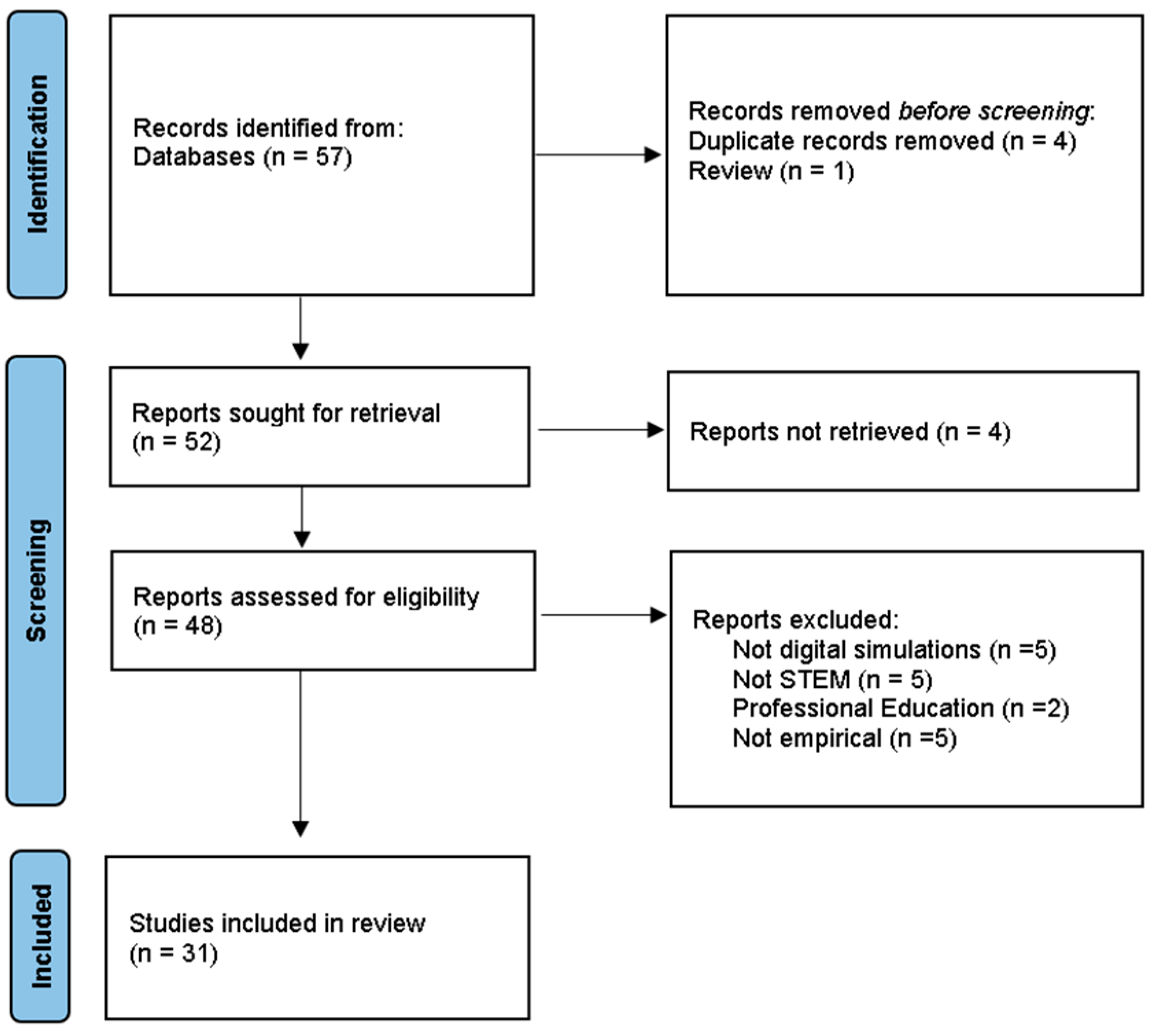
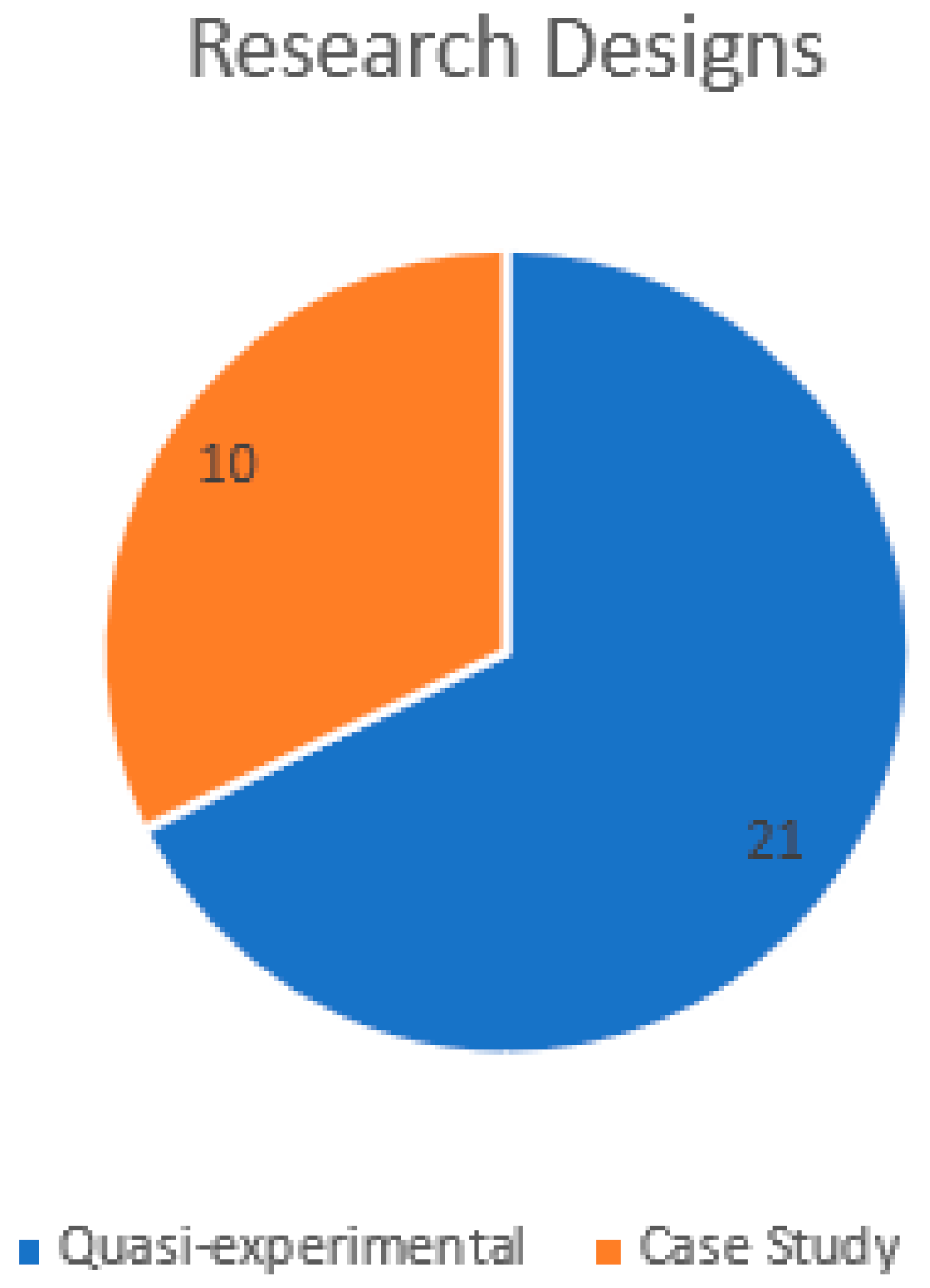
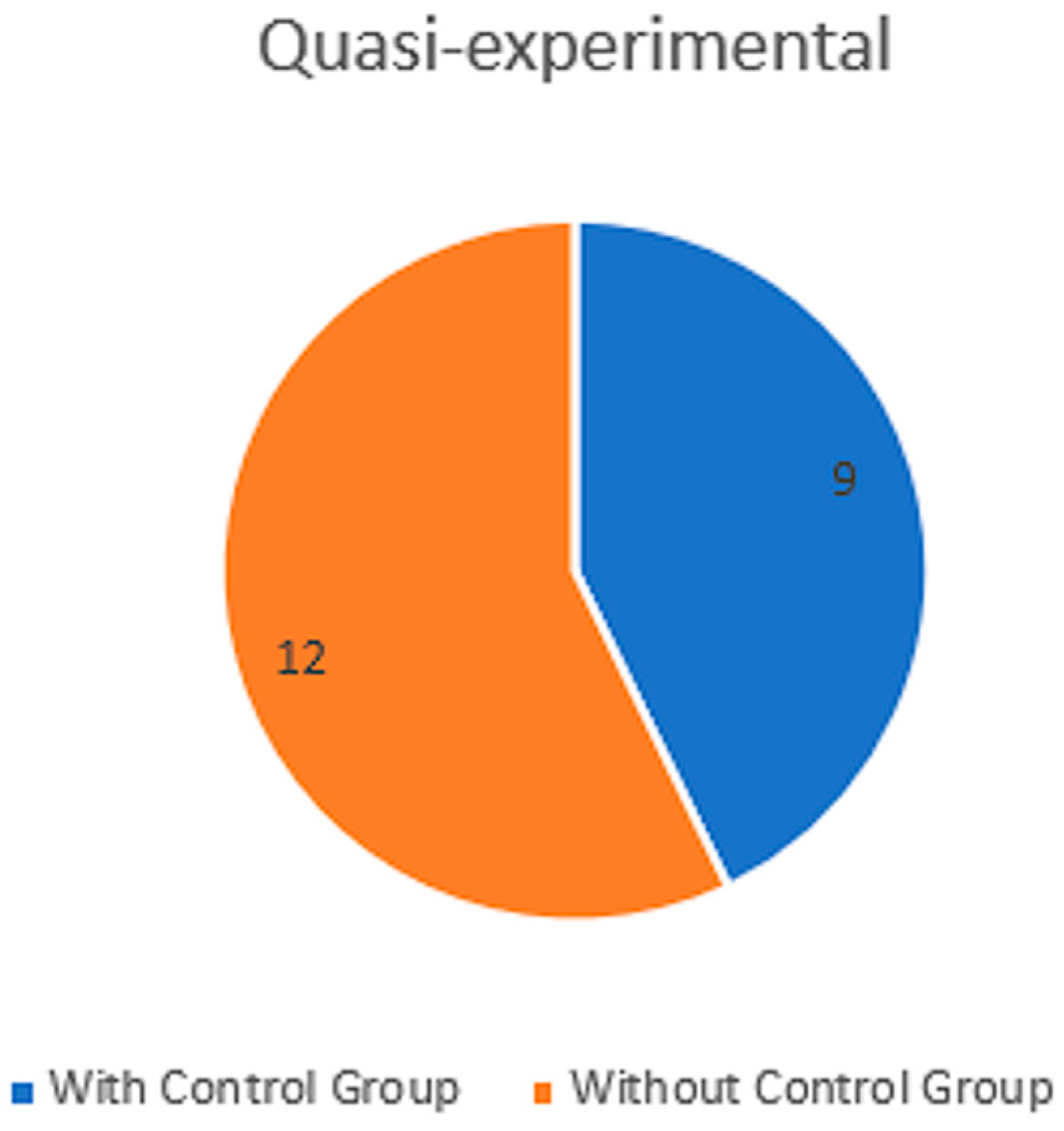
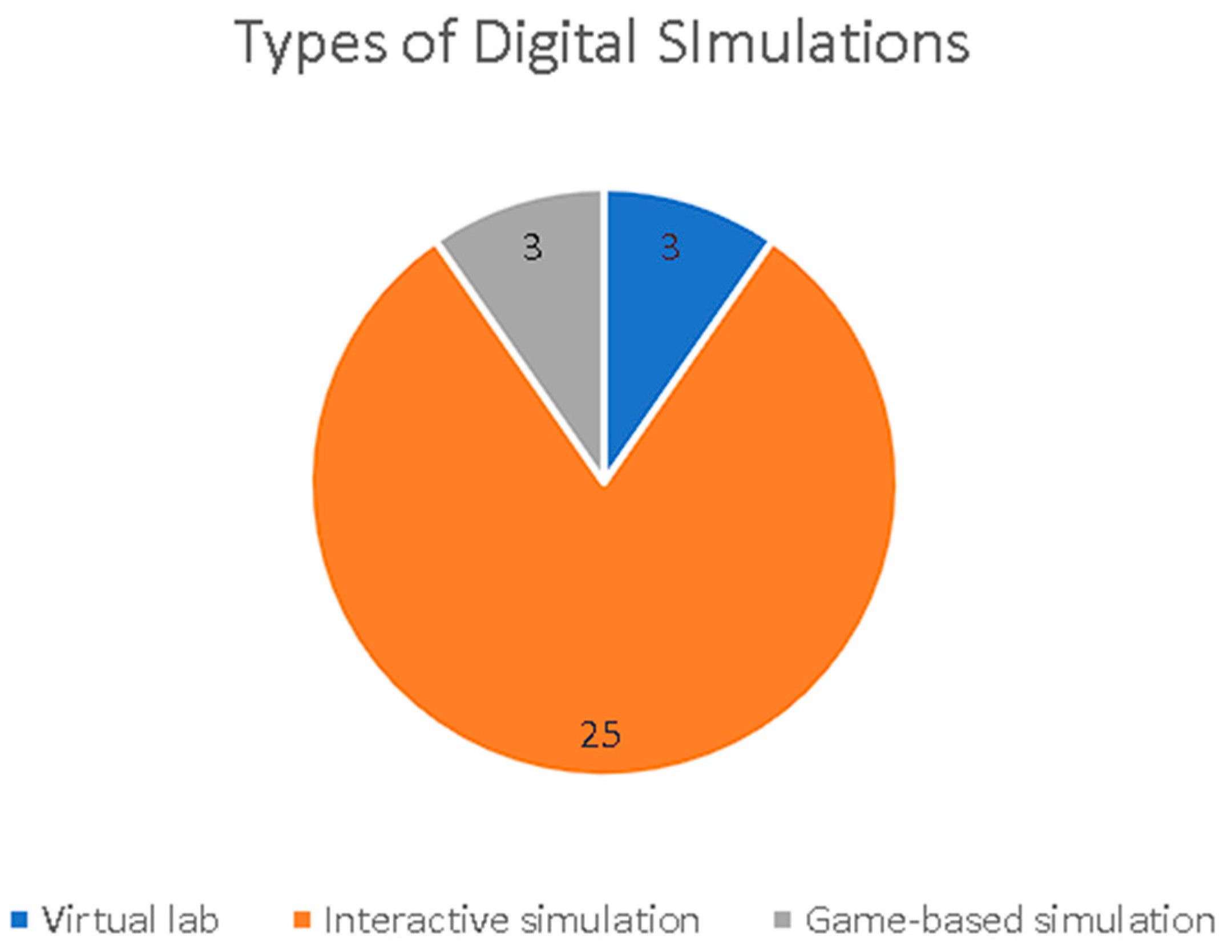
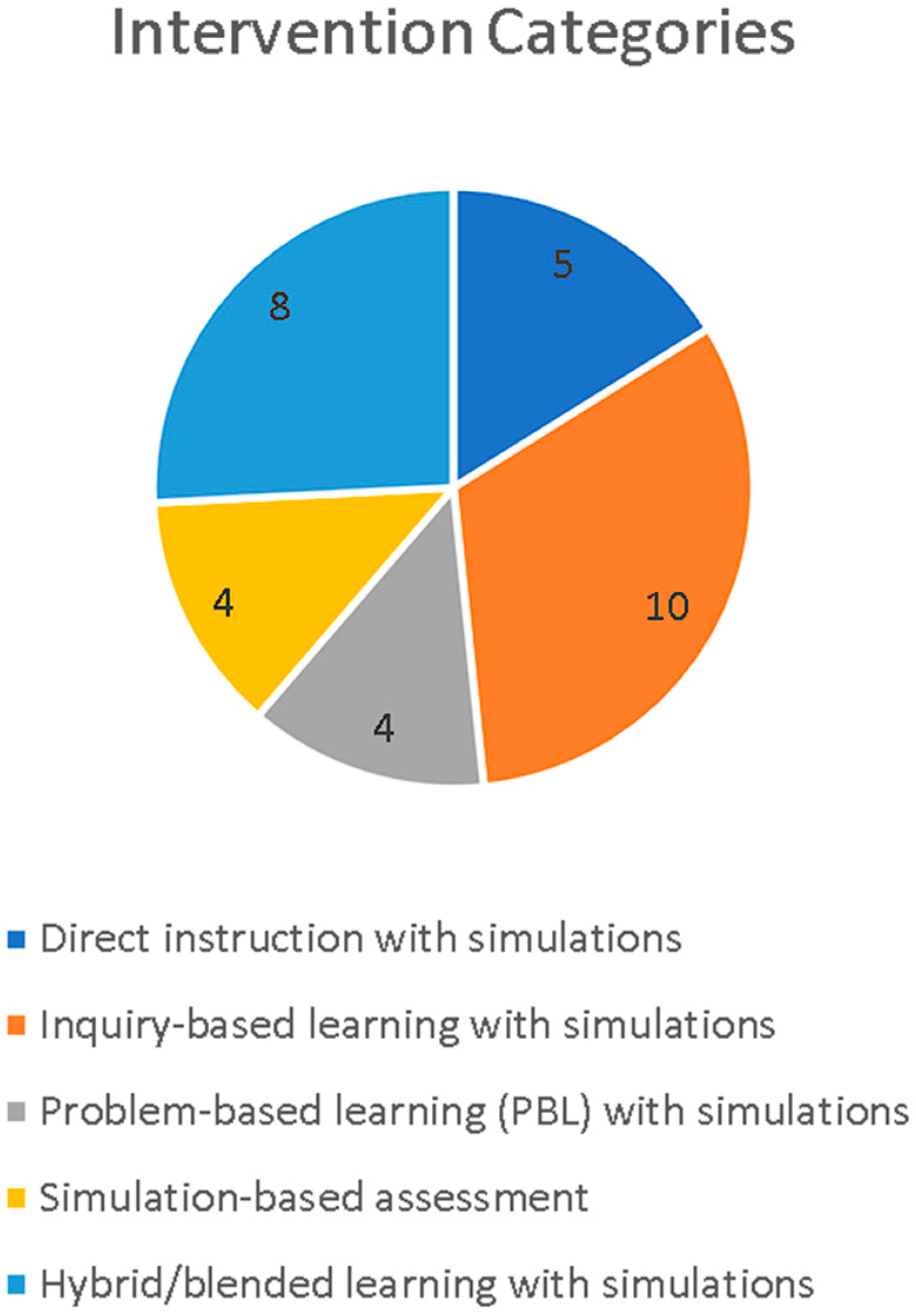
| Author(s) | Year | Study Design | STEM Subject | Intervention Category | Level |
|---|---|---|---|---|---|
| AYASRAH, Firas Tayseer Mohammad et al. [11] | 2024 | Quasi-experimental | Physics | Direct instruction with simulations | Secondary |
| Hüseyin Ateş, Mustafa Köroğlu [12] | 2024 | Quasi-experimental | Science | Hybrid/blended learning with simulations | Secondary |
| Demelash, M., Andargie, D., and Belachew, W. [13] | 2024 | Quasi-experimental | Chemistry | Project-based learning with simulations | Upper secondary |
| Yu-Chen Chiang, Shao-Chieh Liu [14] | 2023 | Quasi-experimental | Engineering | Inquiry-based learning with simulations | Secondary |
| ALARABI, Khaleel et al. [15] | 2022 | Quasi-experimental | Physics | Hybrid/blended learning with simulations | Secondary |
| Kari Kleine, Elena Pessot [16] | 2024 | Case study | Engineering | Simulation-based assessment | Upper secondary |
| Badarudin, R., and Husna, A. F. [17] | 2024 | Quasi-experimental | Engineering | Simulation-based assessment | Upper secondary |
| Victoria Olubola Adeyele [18] | 2024 | Quasi-experimental | Science | Hybrid/blended learning with simulations | Primary |
| Cottone, Amanda M. et al. [19] | 2021 | Case study | Science | Inquiry-based learning with simulations | Primary |
| Turki Alqarni [20] | 2021 | Quasi-experimental | Science | Hybrid/blended learning with simulations | Secondary |
| Yang Wang [21] | 2022 | Quasi-experimental | Physics | Direct instruction with simulations | Secondary |
| YAN, Shenzhong et al. [22] | 2023 | Quasi-experimental | Chemistry | Simulation-based assessment | Upper secondary |
| WENG, Cathy et al. [23] | 2023 | Quasi-experimental | Engineering | Hybrid/blended learning with simulations | Upper secondary |
| Zaher, A.A., Hussain, G.A., and Altabbakh [24] | 2023 | Case study | Engineering | Inquiry-based learning with simulations | Upper secondary |
| Sui, C.J., Chen, H.C., Cheng, P.H., and Chang, C.Y. [25] | 2023 | Quasi-experimental | Science | Inquiry-based learning with simulations | Secondary |
| DAM-O, Punsiri et al. [26] | 2024 | Quasi-experimental | Physics | Inquiry-based learning with simulations | Secondary |
| Michal Dvir, Dani Ben-Zvi [27] | 2022 | Case study | Science | Inquiry-based learning with simulations | Secondary |
| Li, M., Donnelly-Hermosillo, D.F., and Click, J. [28] | 2022 | Quasi-experimental | Chemistry | Project-based learning with simulations | Secondary |
| Yuli Deng, Zhen Zeng, Kritshekhar Jha, Dijiang Huang [29] | 2022 | Case study | Engineering | Problem-based learning (PBL) with simulations | Upper secondary |
| Khadija El Kharki, Khalid Berrada, Daniel Burgos [30] | 2021 | Case study | Physics | Hybrid/blended learning with simulations | Upper secondary |
| Jaakkola, T., Nurmi, S., and Veermans, K. [31] | Quasi-experimental | Physics | Inquiry-based learning with simulations | Primary | |
| Hua-Huei Chiou [32] | 2021 | Quasi-experimental | Science | Direct instruction with simulations | Secondary |
| Nicholas O. Awuor, Cathy Weng, Isaac M. Matere, Jeng-Hu Chen, Dani Puspitasari, Khanh Nguyen Phuong Tran [33] | 2024 | Quasi-experimental | Engineering | Direct instruction with simulations | Secondary |
| Moch Rifai, Siti Masitoh, Bachtiar S. Bachri, Wawan H. Setyawan, Nurdyansyah, Hesty Puspitasari [34] | 2020 | Quasi-experimental | Engineering | Inquiry-based learning with simulations | Upper secondary |
| Muhammad Rashid [35] | 2020 | Case study | Engineering | Problem-based learning (PBL) with simulations | Upper secondary |
| Cathy Weng, Khanh Nguyen Phuong Tran, Chi-Chuan Yang, Hsuan-I. Huang, Hsuan Chen [36] | 2024 | Quasi-experimental | Engineering | Hybrid/blended learning with simulations | Secondary |
| Wang Yang et al. [37] | 2023 | Quasi-experimental | Science | Hybrid/blended learning with simulations | Secondary |
| Amélie Chevalier, Kevin Dekemele, Jasper Juchem, Mia Loccufier [38] | 2021 | Case study | Engineering | Direct instruction with simulations | Upper secondary |
| Debarati Basu, Vinod K. Lohani [39] | 2023 | Quasi-experimental | Engineering | Simulation-based assessment | Upper secondary |
| Paul N. McDaniel [40] | 2022 | Case study | Science | Inquiry-based learning with Simulations | Upper secondary |
| Sertaç Arabacıoğlu, Hasan Zühtü Okulu [41] | 2021 | Case study | Science | Inquiry-based learning with simulations | Upper secondary |
| Outcome Category | Description | NS | References |
|---|---|---|---|
| Learning outcomes | Conceptual understanding, knowledge retention, and practical application skills | 14 | [12,14,23,25,26,28,30,31,32,33,34,35,36,38] |
| Student engagement | Behavioral, cognitive, and emotional dimensions, including motivation and interest | 8 | [13,16,19,21,28,38,39,40] |
| Skill development | Problem-solving, analytical skills, and reflective thinking | 5 | [22,24,25,29,36] |
| Attitudinal changes | Enjoyment of science lessons, career interest in STEM, and attitudes toward inquiry | 2 | [11,31] |
| Teacher competencies | Effectiveness in designing simulation-based activities | 1 | [41] |
Disclaimer/Publisher’s Note: The statements, opinions and data contained in all publications are solely those of the individual author(s) and contributor(s) and not of MDPI and/or the editor(s). MDPI and/or the editor(s) disclaim responsibility for any injury to people or property resulting from any ideas, methods, instructions or products referred to in the content. |
© 2025 by the authors. Licensee MDPI, Basel, Switzerland. This article is an open access article distributed under the terms and conditions of the Creative Commons Attribution (CC BY) license (https://creativecommons.org/licenses/by/4.0/).
Share and Cite
Kefalis, C.; Skordoulis, C.; Drigas, A. Digital Simulations in STEM Education: Insights from Recent Empirical Studies, a Systematic Review. Encyclopedia 2025, 5, 10. https://doi.org/10.3390/encyclopedia5010010
Kefalis C, Skordoulis C, Drigas A. Digital Simulations in STEM Education: Insights from Recent Empirical Studies, a Systematic Review. Encyclopedia. 2025; 5(1):10. https://doi.org/10.3390/encyclopedia5010010
Chicago/Turabian StyleKefalis, Chrysovalantis, Constantine Skordoulis, and Athanasios Drigas. 2025. "Digital Simulations in STEM Education: Insights from Recent Empirical Studies, a Systematic Review" Encyclopedia 5, no. 1: 10. https://doi.org/10.3390/encyclopedia5010010
APA StyleKefalis, C., Skordoulis, C., & Drigas, A. (2025). Digital Simulations in STEM Education: Insights from Recent Empirical Studies, a Systematic Review. Encyclopedia, 5(1), 10. https://doi.org/10.3390/encyclopedia5010010










